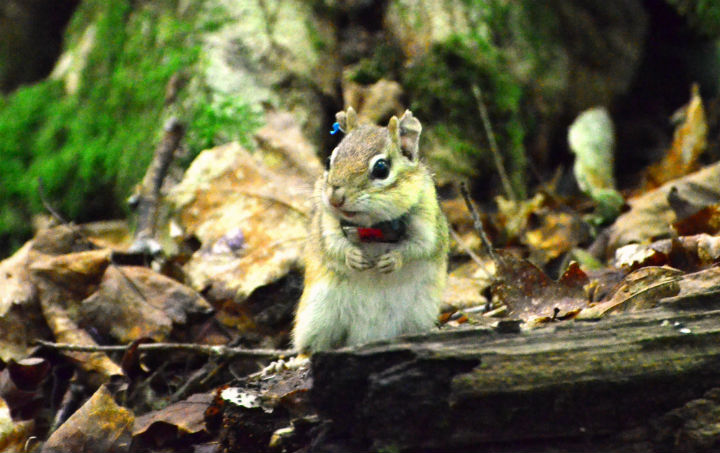WATCH: Mike Armstrong on the tiny technology being used to keep tabs on chipmunk chatter.

A Quebec biologist was hit with a dilemma: how could she record chipmunk chatter in the wild?
Charline Couchoux found the solution online, on a website selling Russian spyware.
Couchoux is in the last year of her doctoral studies at the University of Quebec in Montreal. She’s studying the behaviour of chipmunks, as part of an ongoing project by a team of researchers.
Each day, she treks down to one of three spots the team has plotted out and spends hours observing the furry forest foragers.
One of the focuses is chipmunk chatter — the sounds they make — but it’s not easy to get quality audio.
A few years ago, Couchoux found Russian spy bugs for sale online and started trapping chipmunks and affixing the miniature microphones around their necks.
“They are the tiniest recorder that exists in the world,” she said. “They are really for spying.”
The Russian bugs record every sound the chipmunk makes for 24 hours.
The researchers then have to trap the rodents again to recover the data. Getting it off the recorder is as simple as plugging it into a computer USB slot.
No one could possibly listen to all the recordings, so software is used to analyze the huge amounts of data.
The bugs cost about $300 each and Couchoux is working with 15 of the devices.
The number one question she gets: “Why chipmunks?”
Couchoux said she never gets bored of the tiny frantic rodents and insists they’re every bit as interesting as monkeys.
“They have such a complex vocal communication that it can be compared to monkeys. That’s for sure.”
- Trudeau says ‘good luck’ to Saskatchewan premier in carbon price spat
- Canadians more likely to eat food past best-before date. What are the risks?
- Hundreds mourn 16-year-old Halifax homicide victim: ‘The youth are feeling it’
- Vacation death: Cuba apologizes after Canadian family receives wrong remains
The crisp audio Couchoux is able to record has led to a discovery.
Chipmunk studies of the past found they made just three distinct sounds: trills, chucks and chips.
Not so, Couchoux told Global News
“Since I started my PhD and I spend so many hours watching them and recording them, I discovered that it’s much more tricky than that. They actually have many different types of calls. ”
Couchoux said she’s found nearly a dozen other variations — the combination of sounds.
“They have stuff that is in between chip and chuck, that I call chop. And they also have some chop-trill and chip-trill and chip-chip-trill and so many stuff that they are doing.”
The study is funded in part by a grant from the National Geographic Society and she recently published her findings in a reported titled Spying on small wildlife sounds using affordable collar-mounted miniature microphones: an innovative method to record individual daylong vocalisations in chipmunks.



Comments